Posts
-
Let's Read the 4e Monster Manual 2: Shark
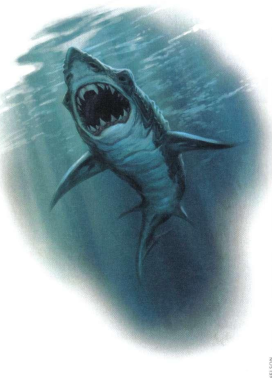
Illustration by Jim Nelson. Copyright 2009 Wizards of the Coast This article is part of a series! Click here to see the rest.
Sharks are are real-world animals, and this Monster Manual 2 entry is their debut on D&D Fourth Edition. The Sahuagin entry from the first Monster Manual mentioned them a lot but that book didn’t have shark stats. The Monster Vault did have them, and we already looked at its take on sharks in the post linked above.
There are many species of real-world sharks, with very varied looks and behavior. Rather than worry about any of that, the Monster Manual 2 gives us a fantastic species based on our worst fears about sharks. Witness the horrible might of the Fleshtearer Shark, the bullete of the sea!
The Lore
Fleshtearer sharks seem to be kinda modeled on the shark from Jaws. They’re big, they’re stupid, they’ll try to eat anything they can bite, and that can include boats. These sharks can thrive anywhere, I do mean anywhere: not only can you find them in oceans of any temperature, they sometimes live in rivers and lakes and even swim in the Underdark.
Fleshtearers can live for hundreds of years and never stop growing, which can make those subterranean sharks even larger and stronger than the typical specimen presented in this entry.
Sahuagin and kuo-toa usually steer clear of fleshtearer sharks because they’re too dangerous to tame, but sometimes a heroic trainer among them will manage the feat. In this case, the “tame” flesh-tearer is used in raids against large ships, eating anyone who falls overboard and biting holes in the hull.
The Numbers
Fleshtearer sharks are Large Natural Beasts with the Aquatic keyword. They’re Level 10 Brutes with 128 HP and low-light vision. They swim at speed 8, but can only flop around at speed 1 on land.
The Aquatic keyword gives the shark a +2 attack bonus against non-aquatic opponents when both are in water, and it also has a custom Waterborne trait that stacks a +2 damage bonus on top of that.
Their basic attack is of course a Bite, but they also have several special maneuvers. Lockjaw Charge is a charge attack that also grabs the target. Grabbed targets are vulnerable to the shark’s shredding teeth, which always hit and deal heavy damage.
The shark has no special ability to pull a grabbed victim along when it moves, so it must use the standard rules for doing that (opposed Strength tests). It can also choose to stay in place while it chews into the victim with Shredding Teeth.
A fleshtearer shark will lurk out of detection range until it picks a target (the tastiest-looking PC). It will then use Lockjaw charge on them, relying on its toughness to weather any opportunity attacks. It will probably release the grab and swim away for another pass rather than getting pinned down by the other PCs, but it’s too obstinate to run and usually fights to the death.
The shark’s bloodlust often gets in the way of those tactics, which is represented by a trait named Feeding Frenzy. When the shark starts its turn within 5 squares of a bloodied creature, it must make a bite attack against a creature adjacent to itself, which will also make it release a grabbed victim if it has one. “Creature” here means both allies and enemies can trigger the effect and be valid targets for the bite attack. Even a “tame” shark is dangerous to its allies.
Sample Encounters and Final Impressions
It’s a movie shark, doing movie shark things. If you’re adventuring on or under water, you might run into it, otherwise it won’t usually impact your adventuring life.
You can make them Huge and level them up to represent Underdark sharks, in which case they might make good thralls for Aboleths and for Mind Flayers who want to fight Aboleths.
We get one sample encounter here:
- Level 10: 2 fleshtearer sharks, 1 sahuagin baron, 2 sahuagin priests. This is likely the “command squad” for a bigger raid against a large ship or coastal village. They’d stay a bit further away from the front lines, and engaging them might be necessary to end the raid.
-
Let's Read the 4e Monster Manual 2: Shadar-kai
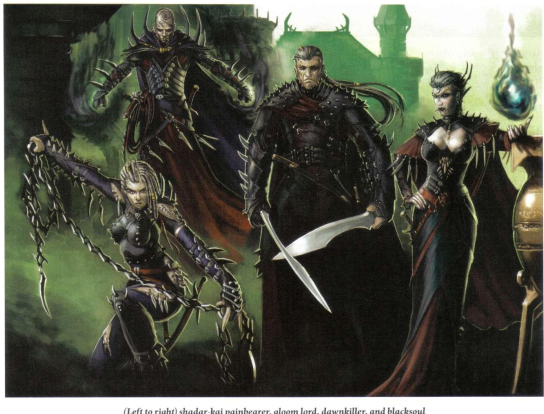
Copyright 2009 Wizards of the Coast This article is part of a series! Click here to see the rest.
We already saw the basic lore of shadar-kai back in [Let’s Read the Monster Manual][2], and the Monster Manual 2 brings a few more stat blocks for them.
This is where they add the lore about Shadar-kai seeking extreme sensations to stave off the soul-draining malaise of the Shadowfell. As I said in the original post, I prefer to ignore this bit. If you want to add it in, the book also mentions that offers of novel and/or intense experiences tend to be well-received when one negotiates with shadar-kai.
In this book we get paragon-tier Shadar-kai, which one can usually meet in the Shadowfell proper. They retain the MM1 signature traits (low-light vision and the Shadow Jaunt ability), and get a new gimmick in the form of a new status effect they can inflict: shrouded in gloom. A victim who is shrouded in gloom takes a -2 penalty to attacks and gains only half the benefit from healing effects. This seems to always be a “save ends” condition. Their ground speed is 7.
Lastly, the new stat blocks presented here were named by someone who decided that simple descriptive names like the “Warrior” and “Witch” of the first book weren’t nearly goth enough. Let’s check them out.
Shadar-kai Blacksoul
Blacksouls are spellcasters specializing in harmful shadow-based magic. They’re level 14 Controllers with 138 HP, and all their attacks are spells. Corrupting Blackfire is a basic melee attack that deals fire and necrotic damage; Shadowbolt is a basic ranged attack that deals necrotic damage; and Shadowburst (recharge 6+) deals necrotic damage over a wide area. All three also shroud the target in gloom on a hit.
The blacksoul’s ultimate attack is Corrupt Soul, which targets Will and dominates (save ends). It can only target victims who are shrouded in gloom.
Shadar-kai Dawnkiller
This absurd edgelord is a Level 14 Lurker with 106 HP. They carry a pair of kukris whose strikes shroud the target in gloom and can also be used to perform a shade strike that does the same damage and blinds instead. Their Shadows of the Raven Queen trait gives them bonus damage against targets who can’t see them.
Dawnkillers likely alternate shade strikes and basic attacks, focusing on a single PC. They pair really well with the spellcasters from this entry, providing an extra source of “shrouded in gloom” so their buddies can use their ultimate attacks earlier.
Shadar-kai Gloom Lord
Gloom Lords are spellcasters of the same tradition as blacksouls, with a slightly different spell selection. They’re Level 14 Artillery with 108 HP.
Their basic attacks are the same, and their special technique is named Shadowcage. This is an at-will ranged attack that targets the Reflex of a creature shrouded in gloom. It deals necrotic damage, restrains the target, and prevents it from moving more than 2 squares away from its original position until it passes a save to clear all of these effects.
Sharar-kai Painbearer
They’re not in pain, they bring the pain to you. Painbearers are Level 15 Skirmishers with the Leader keyword and 144 hP. They wear leather and wield spiked chains.
Their basic attack is named shadow chain, which does damage and shrouds in gloom as usual. They can also perform a Shadow Dance that allows them to shift their speed and make three shadow chain attacks against different targets along the way. Each attack after the first deals an extra 2d6 damage for every previous attack that hit.
That’s the Skirmisher part. The Leader part comes from two other abilities. The first is a Shadow Weft aura (5) that allows shadar-kai allies within to shift 1 square after they hit with a melee attack. The second is Shadow Boon, a reaction that allows an ally within 10 squares to re-roll an attack they just missed.
Sample Encounters and Final Impressions
I’m surprised we didn’t get a stat block that was literally named Shadar-kai Edgelord.
Typical shadar-kai combat encounters will be either agains the villainous sort that consorts with undead, or the morally ambigious yet antagonistic sort that swears fealty to the Raven Queen. A more complex encounter might find the PCs aiding the latter against the former. Either sort of shadar-kai might be riding nightmares, because of course they would.
We get two sample encounters here:
-
Level 13: two dawnkillers and a painbearer accompanied by a bodak. Undead-loving villains.
-
Level 14: A blacksoul, 2 gloom lords and 2 painbearers. A team where every member is a brooding loner, Kamen Rider-style.
-
-
Let's Read the 4e Monster Manual 2: Retriever
This article is part of a series! Click here to see the rest.
Retrievers first appeared in the Fiend Folio for AD&D 1st Edition. They make their 4e debut here in the Monster Manual 2.
The Lore
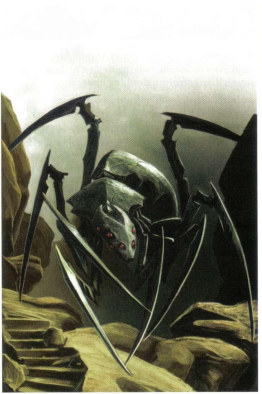
Copyright 2009 Wizards of the Coast Retrievers are powerful constructs shaped like giant spiders, built by the primordials themselves during the Dawn War to carry out kidnappings, thefts, and assassinations. They’re not smart enough to do anything outside their intended function, but when it comes to their mission there’s no one better in existence.
Once given a target, a retriever can track it from anywhere in the multiverse and teleport to its location instantly. If they’re retrieving, they can grab the target and skedaddle. If they’re assassinating, they can count on their huge size, bladed legs, and multi-directional eye rays to flatten almost any opposition.
The primordials can really build things to last when they care to. A significant number of retrievers survived the War and is still active today, which is very bad news for the world because some demons have learned how to command them. Back in the days of AD&D, retrievers were linked to Demogorgon in particular, but now they could be found in the service of any demon lord or other entity of similar power. Perhaps some of them still act at the behest of a primordial, and Lolth is spidery enough to want a bunch of them working for her. Make any of them angry enough and a few retrievers might show up at your home.
The Numbers
Retrievers are Huge Elemental Animates, but though they are described as constructs they lack the Construct keyword. They’re Level 27 Soldiers with 248 HP, immunity to Charm and Fear, and Resist 5 to all damage. They run at speed 8, but have no climb speed despite looking like spiders. Their special senses include darkvision and truesight 10.
A retriever has Reach 3 and two basic attacks: a standard Claw strike and Retrieve, which targets Fortitude, deals claw damage and grabs the target. A retriever can move its grabbed victim without needing to make Strength tests, so they can easily “grab and go”.
It also has access to four different eye rays, each pairing a type of elemental damage with a different rider: acid and blindness, cold and immobilization, fire and ongoing damage, thunder and stun. The creature can fire all four in the same action, but must target a different creature with each. At the start of each turn, a random ray recharges. This means a second full blast takes a while, but it can fire a partial one if needed.
If the retriever is hard-pressed it can take an action to engage in Self-Repair, recovering 20 HP and gaining a +4 bonus to AC for a turn. This recharges once it’s first bloodied. Might be a good thing to do when it manages to run away with its victim.
And finally we have the power that makes it truly fearsome: Unerring Accuracy, which allows it to sense the approximate location of its target and teleport to within 10 squares of it from anywhere in the multiverse. Demogorgon is pissed at you, gives your name to a retriever in his throne room and bam, giant spider mech bursting through your bedroom wall. This is a daily power, so I guess a retriever on a kidnapping mission needs at least a few hours before it can return to its master. That’s your window to rescue them.
The order doesn’t even have to be very specific. “Bring me an elf” will allow it to teleport to the location of the nearest elf, and so on.
Sample Encounters and Final Impressions
Despite being an epic spider mech, the retriever is a Regular, which means it will usually be found as part of a group. This can mean “multiple retrievers”, or it can mean other epic assassin-types who hitch a ride on the teleport. Maybe they’re riding a howdah atop the spider body - it’d be the perfect place for some epic artillery or controller monsters.
Alternatively, they might be found under the command of a less sophisticated type of demon who prefers to use them as bodyguards and extra muscle in a more straightforward combat scenario.
The sample encounter could belong to either type: a marilith with an entourage composed of an abyssal rotfiend and 2 retrievers (level 26).
-
Let's Read the 4e Monster Manual 2: Remorhaz
This post is part of a series! Click here to see the rest.
I first encountered remorhazes in the 3e Monster Manual, though I guess they’ve been around since AD&D.
The Lore
Remorhazes are yet another example of the dangerous megafauna that plagues D&D worlds: gigantic predators with a somewhat centipede-like appearance that inhabit the colder reaches of the world. They’re also one of those gotcha monsters, because despite living in cold biomes their powers are heat-based. A remorhaz can heat its carapace up to an extremely high temperature, which really ruins the day of the usually-weak-to-fire creatures it feeds on.
A remorhaz is big enough to swallow a frost giant or adult dragon whole, and while it use that as a combat maneuver it prefers to do it when the prey in question is no longer fighting back.
Frost giants sometimes risk training these creatures. A few of them even succeed.
The Numbers
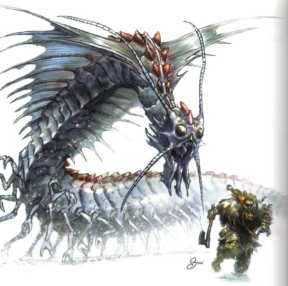
Copyright 2009 Wizards of the Coast Remorhazes are Huge Elemental Beasts, and Level 21 Elite Brutes with 480 HP. It has low-light vision and projects an aura (2) of Blistering Heat that does 10 fire damage to any creature caught inside. It runs at speed 6 and burrows at speed 4 with Tunneling.
Their basic attack is a Reach 2 Bite that damages and grabs on a hit. After grabbing a creature they can spend a minor action to try to Swallow it (an attack vs. Fortitude). The beast’s insides deal 10 physical and 10 fire damage to swallowed victims at the start of its turn. The victim is considered restrained, with line of sight and effect only to the remorhaz itself. It can use only melee or close attacks (with penalties from the Restrained condition), and if it manages to deal 30 damage the remorhaz will spit them out. Killing the creature also allows the victim to escape, of course.
There’s an oversight here, I think, because the ability doesn’t list a size limit for which creatures can be swallowed. I’d say Large or smaller is a good value for that.
The remorhaz can also Trample, moving its speed, crossing enemy spaces, and making a physical attack that damages and knocks prone against each enemy whose space it moves through.
That heated carapace can do more than project an aura, too. It can flare up in an Immolating Carapace attack (close burst 1 vs. Reflex; recharge 6) that deals fire damage and inflicts ongoing fire damage that lasts while the targets are adjacent to the beast. Yes, this stacks with the aura.
While the remorhaz is bloodied, it can also use Enraged Heat to deal automatic fire damage to someone who hits it in melee.
A good tactic for them seems to be to bite and swallow a PC who can’t put up much of a fight from the inside, and then run around trampling and roasting the rest with Immolating Carapace to prevent them from surrounding the remorhaz. An individual who’s only interested in a quick meal might even try to swallow a PC and run away to digest them.
Remorhazes being used as attack beasts by giants will be more ready to fight a battle to the end, and in that case they might wait to swallow a PC who falls to 0 HP. The others would need to kill the creature in order to heal their buddy. Welcome to epic level!
Sample Encounter and Final Impressions
The sample encounter is level 18: A frost giant acting as a beastmaster of sorts, accompanied by a remorhaz and a rime hound.
I confess that I had a bit of a hard time distinguishing between a remorhaz and a behir in earlier editions. The distinction is clearer to me now, but only because I spent some time studying their entries in detail.
-
Let's Read the 4e Monster Manual 2: Phoelarch
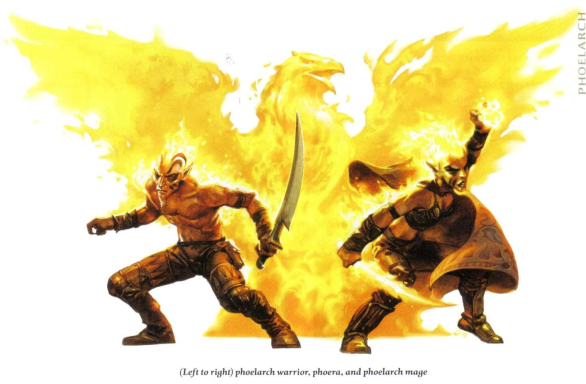
Copyright 2009 Wizards of the Coast This post is part of a series! Go here to see them all.
I seem to remember phoelarches appearing in one of the late Monster Manuals for 3e. I don’t know if they appeared before that. Their 4e debut is here in the MM2.
The Lore
A Phoelarch is a fiery humanoid native to the Elemental Chaos. Their orange skin and fiery hair makes them look kinda like a human-like version of the azer, or a slightly differerent fire genasi. They’re typically nomadic and adventurous, and so could be found wandering anywhere in the universe. But when you see a phoelarch you’re seeing just half the picture.
The soul of every phoelarch is connected to that of a phoera, a fire bird that’s pretty much a mini-phoenix. Phoeras soar through the skies of the Elemental Chaos, living their bird lives. Though smaller than phoenixes, they’re still giant territorial birds of prey and have quite a temper, so they can end up attacking passing adventurers.
Typically, a phoelarch doesn’t have a lot to do with their phoera and vice-versa. They have a vague sense of each others’ personality and emotions, but each lives their own life, and has thoughts and concerns that are utterly alien to the other. It’s quite possible for them to never meet.
However, when one member of the pair is killed, the connection instantly summons the other one, which will arrive knowing what happened and will be understandably very angry at the perpetrators. Since phoelarches are more widespread, the most common scenario likely has the PCs fighting them first and then the phoera, but I suppose it could happen the other way around. As long as one member of the pair survives, the other will eventually return to life.
The Numbers
Phoeras are Medium Elemental Magical Beasts with the Fire keyword. The two phoelarches we get here are tagged as Medium Natural Humanoids, but I really think they should be Elemental as well and have the Fire keyword. As sapient humanoids, a lot of their abilities come from training, so we get two stat blocks for them. They still tend to use a lot of fire, though.
All the individual stat blocks here are regulars, but they’re really “disguised” elites when you think about it.
Phoelarch Mage
Phoelarch mages love fire magic, and travel the world looking for adventuresome mentors who can teach them using practical lessons instead of classroom work. Some seek out their linked phoeras in order to gain a deeper understanding of their link and of fire magic in general.
This Phoelarch Mage is Level 12 Artillery with 93 HP. They have Resist 10 Fire, Vulnerable 5 Cold, and project an aura (1) of Phoenix Heat, which deals 5 damage to any creatures caught inside. That means you should be careful with their formation if they’re partnering up with flammable allies. Their ground speed is 6.
The mage’s basic attacks are a burning dagger and a Range 20 phoenix ray, both of which deal fire damage. They also know a spell named Flames of the Phoenix (recharge 5+), which is pretty much your typical fireball: area effect, fire damage, plus ongoing fire damage. Presumably they also know plenty of non-combat rituals, but those don’t appear in stat blocks.
When the mage drops to 0 HP their Rise from the Ashes ability triggers and they explode. This deals heavy fire damage (vs. Reflex) in a Close Burst 2. It also creates a zone of fire that lasts until the end of the encounter and damages anyone caught inside. Finally, when the mage’s next turn comes up, a phoera appears within the zone and joins the fight.
Phoelarch Warrior
Phoelarch warriors are usually wandering mercenaries that seek to get hired as independent skirmishers and special forces. While their moral outlook is as varied as that of any sapient, even a dastardly warrior will usually refuse to work for slavers.
This Warrior is a Level 12 Skirmisher with 114 HP. They have the same resistances and aura as the mage, and a Speed of 7. Their main attack is a burning falchion that deals fire damage and is a High-Crit weapon. They also have a Burning Step trait that deals automatic fire damage to anyone who hits them with an opportunity attack.
Like the mage, the warrior also explodes when dead, creating a fiery zone and being replaced by their phoera in the next turn.
Phoera
Phoeras are level 12 Skirmishers with 114 HP. As magical beasts they’re sapient and can talk, but their toughts are usually a bit alien to your typical humanoid and even to their linked phoelarch. They have Resist 15 Fire and Vulnerable 5 Cold, and a damaging fire aura (2) similar to that of the phoelarch, but larger. They run at speed 6 and fly at speed 10.
Phoeras fight with claws that do physical and ongoing fire damage, and can shoot feathers of flame in a close blast 4 pattern. They can perform either of those as part of a Flyby Attack as well, flying their speed without provoking opportunity attacks and making the attack at any point in the move.
When they die, they explode and leave a fiery zone just like a phoelarch. If their phoelarch is already dead, that’s the end of it. If not, it’d make sense for the phoelarch to appear in this zone next turn.
Sample Encounters and Final Impressions
The sample encounter is level 12: a phoelarch warrior who fell in with a briar witch dryad and a few snaketongue cultists. Do mind your positioning on this one, as all of the phoelarch’s allies are very flammable.
I like the phoelarch/phoera gimmick! Without it, they’d be just another “generic fire guy” alongside azers, genasi and salamanders.
subscribe via RSS